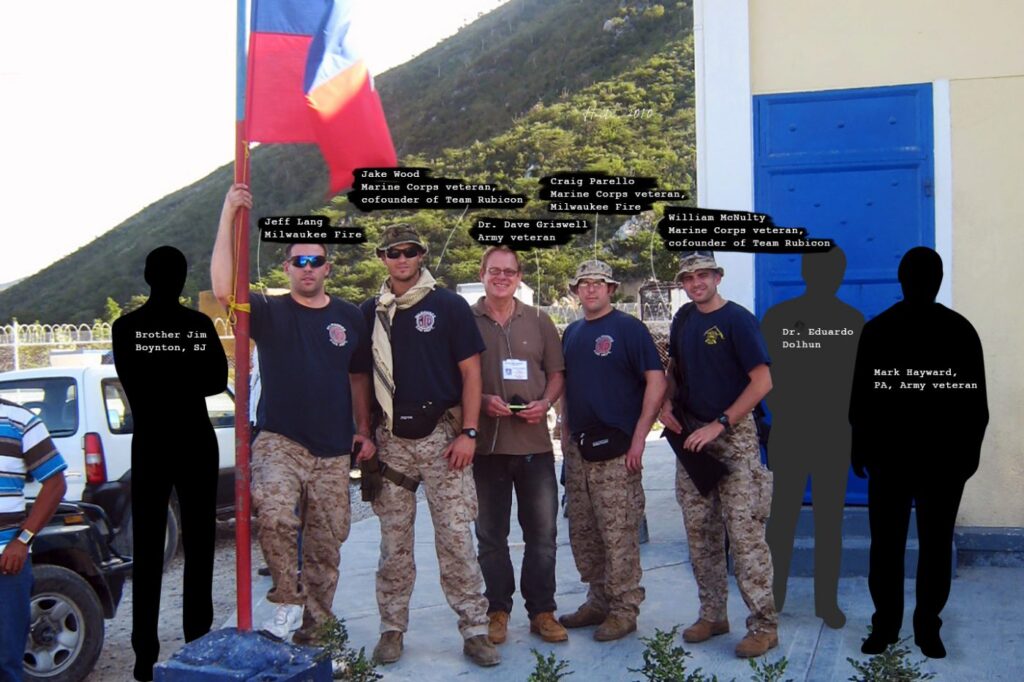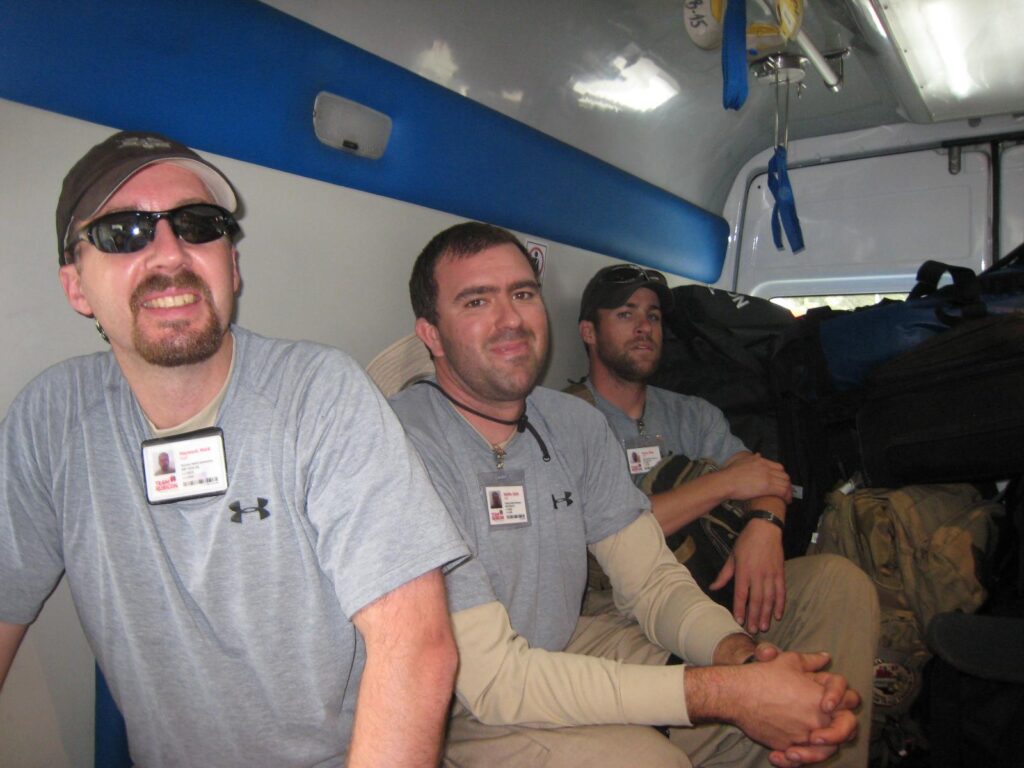The grey t-shirt. It has become more than just a symbol for our organization. It represents an ethos of service, commitment, and sacrifice. Each year, tens of thousands of volunteers pull that simple, unassuming t-shirt over their heads and commit to transforming their communities.
The grey shirt has become so representative of Team Rubicon that our volunteers have assumed its name as their preferred moniker: Greyshirts. They work every day to “earn their shirt” and live up to the legacy of those volunteers who came before them. Some days it enters the field of service crisp and clean, but it rarely leaves that way.
But, where did the Team Rubicon grey shirt come from?
A First Mission and a Cobbled Together Uniform
When Team Rubicon deployed on its first mission to Haiti the organization as we know it today didn’t exist: We weren’t a registered nonprofit organization, and the team was just four volunteers—me; my college roommate and Milwaukee firefighter, Jeff Lang; Jeff’s fellow firefighter and a former Marine, Craig Parello; and Marine veteran William McNulty. We had no uniforms. In the frantic 48 hours between the decision to go to Haiti and the day we arrived, we made a number of snap decisions: We called our team Rubicon, and we cobbled together uniforms consisting of military BDU pants and navy blue Milwaukee Fire Department shirts in an effort to convey some semblance of being official. (Neither the military nor the MFD sanctioned this mission, and we’ve since refrained from letting volunteers wear military garb on international operations.)

That ragtag uniform served Team Rubicon well in Port-au-Prince, but upon returning to the U.S.—and committing to building a robust response organization—my cofounders and I set out to establish more appropriate uniforms. But we didn’t have much time to sit around and daydream about what they’d look like. A few short weeks after returning from Port-au-Prince, Chile was hit with a massive 8.8-magnitude earthquake unleashing a deadly tsunami. Team Rubicon sprang into action.
Off the Clearance Rack and Onto the Backs of Our Team
In need of supplies, the team headed to a local REI where someone suggested we all grab the same shirt to look like a team. Naturally, we made our way to the clearance rack to look for shirts of the single color that also came in a variety of sizes. Our choices were white, black, light blue, or grey. White would get too dirty. Black too hot. Light blue wasn’t considered. Grey it was. We each grabbed two in our respective sizes and headed to the register and then on to the Chilean coast.
The grey shirt made its debut on Operation Fuerza Chile, where five volunteers—William McNulty, Clay Hunt, Mark Hayward, Zach Smith and myself—spent just over a week liaising with the Chilean military and conducting medical clinics in remote villages along the coastline.

Returning from Chile, we began thinking in earnest about Team Rubicon’s image. We worked with our designer, Sarah Lenger—who happens to be my sister—to design a logo. After going through a creative brief, Sarah came back with her initial designs. One stuck out: A cross, on its side, with the Rubicon River flowing through it. A few design tweaks later, the TR “X” was born. In years to come hundreds of volunteers would tattoo that X on their bodies.
The shirt design needed to be bold. Since Team Rubicon was the new kid on the block, it was important to prominently display the organization’s name across the front. At the time, in 2010, we imagined the organization solely would do international medical work. The initial designs for the back included the word “medic” or “doctor” in seven languages—English, Spanish, French, Mandarin, Hindi, Russian and Arabic.
Still, something was missing. As primarily a volunteer organization, many responders would be meeting each other for the first time in the field. After a little debate, the unmistakable white box where volunteers would scribble their names was added.
Choosing the Grey Shirt
V
The next question would prove the most critical. What color would the shirts be? Our decision to wear grey shirts in Chile was the result of limited options. As we debated other options, I received a call from my good friend, Joe Thomas. He and I had played football together at Wisconsin, and at the time Joe was in his fourth season in the NFL and an Under Armour athlete. He said he’d called his rep at the sports company and request that they outfit his buddy’s disaster response group. The company agreed but wanted to donate only excess inventory. That inventory just happened to be grey moisture-wicking shirts.

Team Rubicon’s iconic grey shirt, officially, was born.
The shirt design has changed very little since then. The largest change coming when were placed the medically-focused back design with a simple “X.”
Though the grey uniform has been in service since the middle of 2010, the term “Greyshirt” gained traction only in 2015. That was the year that I sat down with our leadership team to articulate and codify the organization’s values as we know them today. In an ode to the military’s articulated objectives, “Mission Accomplishment, Troop Welfare,” we came up with the value statement “Mission First, Greyshirts Always.” Because our volunteers aren’t your average run-of-the-mill volunteers, because they are a special breed, they deserved a special name. We wanted Team Rubicon to be a way of life as much as it is an activity, and thus we aspired to have our volunteers closely identify with the organization. What better way than for them to take on a name that reflected our most iconic imagery? Though I also must admit that I grew up a Nebraska Cornhusker football fan, and their legendary defenses of the 1990s were known as the Blackshirts because of the black practice jersey conferred to its defensive starters.

In the nine years since we founded Team Rubicon, Greyshirts have deployed on six continents and in all 50 states. People around the world have had hope restored when they watch armies of volunteers clad in grey march into their communities to serve. Likewise, those very same volunteers have felt rekindled purpose each time they pull on their grey shirts.
To all the Greyshirts in service across the globe, thank you.



